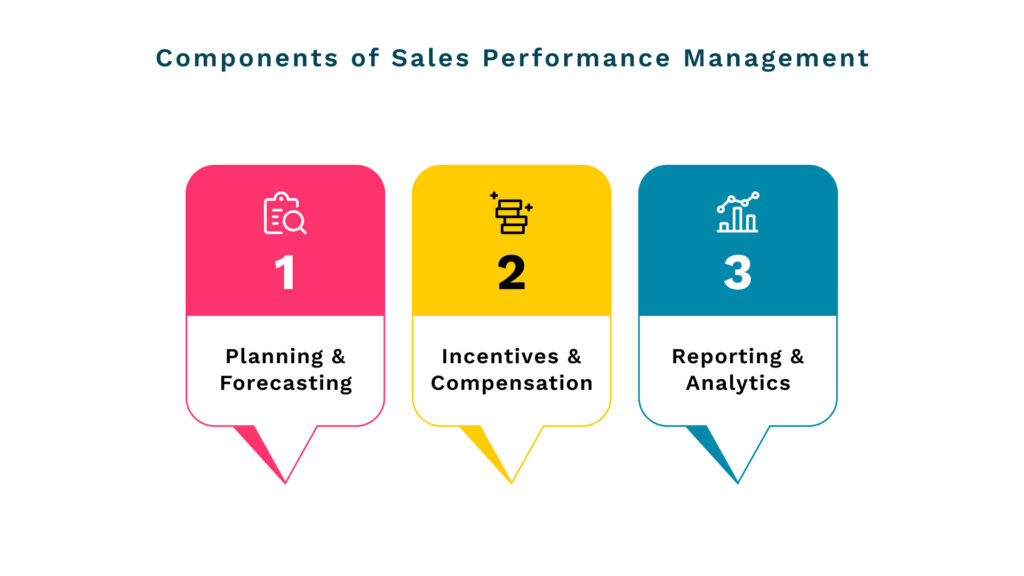Top sports teams execute flawlessly under pressure.
It’s not just talent that helps them do this.
They’re counting on help from off the field to close the gap.
Coaches watch every move and give timely signals (hand gestures) for players to follow.
The tactics related to each signal are practiced to perfection for months.
And the execution is flawless.
Sales performance management strategies do the same for sales reps.
They help them link their individual sales goals to business needs.
And deliver growth – month after month,
But, as in sports, your approach must be tailored to your team.
To do this, you need real-time data and a willingness to experiment.
In this article, we’ll cover proven tips and strategies for sales performance management.
Let’s get started.
What is Sales Performance Management?
Sales performance management is about empowering sales reps to perform at their best.
It involves planning, tracking, and optimizing sales processes and systems to drive revenue.
SPM is not limited to sales ops alone.
It is a cross-functional approach that uses real-time data to find growth opportunities.
Effective sales performance management boosts sales productivity, effectiveness, and efficiency. It integrates:
- Pipeline management
- Forecasting
- Territory planning
- Quota alignment
- Reporting and analytics
- Incentive structuring
What are the Components of Sales Performance Management?
There are three key components of Sales Performance Management:

1. Planning and Forecasting
This is the ‘where’ and ‘who’ of your GTM strategy where you:
- define the market
- slice it into segments
- assign territories,
- and set sales quotas for each rep on your team.
Do this right and you’ve won half the battle.
2. Incentives and Compensation
Now that you have mapped your market, and assigned it, let’s think about ‘how’ to drive revenue growth.
This is where the commission structure comes in.
Many organizations have incremental tiers based on role and level of responsibility.
For example, inside sales rep (Tier 1), account executive (Tier 2), and sales manager (Tier 3).
There may be extra bonuses for growing key accounts or territories.
Incentives and compensation are key levers that can motivate reps.
3. Reporting and Analytics
Filtering data into actionable insights is the ‘what’ of sales performance management.
It helps sales managers measure and manage sales performance objectively.
For example, reports can uncover the real reasons behind a sudden drop in new deals- process gaps or skill gaps.
But before you use the data, make sure it’s safe to use.
In other words, it must be complete and accurate in all respects.
The right data can connect the dots and improve sales productivity and efficiency.
What are the Benefits of Sales Performance Management?
Implementing a Sales Performance Management framework can enable revenue teams to:
- Make better decisions through data and analytics.
- Track pipeline from lead to close
- Improve forecasting accuracy
- Improve territory alignment
- Set realistic quotas
- Motivate reps through effective compensation and incentives.
- Provide effective sales training and coaching.
- Shorten the sales cycle.
- Deliver a better customer experience.
- Identify opportunities for cross-sell and up-sell.
- Improve process efficiency with automation.
Metrics to Measure Sales Performance:
Sales teams use a combination of metrics to track individual and rep-level sales performance. Some of the top metrics are:
1. Conversion Rate
This is the percentage of opportunities that turn into signed contracts.
A below-average conversion rate could mean you have a leaky pipeline or an inefficient sales process.
Conversion Rate Formula:

For example, if a sales rep converts 6 out of 60 qualified leads into paying customers, the conversion rate is 10%.
2. Win Rate
Win rate refers to the percentage of deals closed in a given month or quarter.
It helps sales managers compare sales over two or more periods.
Win Rate Formula:

For example, if a sales rep closes 20 deals out of 50 that were quoted, their win rate would be 40%.
3. Quota Attainment
As the name suggests, quota attainment is the actual quota achieved versus the goal.
It helps sales managers identify top performers and average performers.
Quota Attainment Formula:

For example, if a sales reps quota is $25,000 in a quarter and they could close deals worth $10,000, their quota attainment would be 40%.
Related Resource: 15 Sales Metrics You Must Track4. Sales Cycle Length
This is the time it takes, on average, for a rep to close a deal.
A long sales cycle is usually caused by a poor sales process.
Sales Cycle Length formula:

For example, if there are three deals that close in a month taking 10, 20 and 24 days respectively, the total number of days to close all deals would be 55 days.
The average sales cycle length in that case would be 54 divided by the total number of deals, which is 3 in this case. The average sales cycle length would be 18 days.
5. Average Deal Size
This is the average value of each deal closed by your team.
As a rule of thumb, high-value deals (.>$1M) take longer to close than smaller deals ($100,000 or less).
Average Deal Size Formula:

For example, if a company closes four deals in a quarter of $20,000, $30,000, $10,000 and $20,000, the average deal size would be $20,000 for that quarter.
6. Sales Productivity
This is the number of sales activities – calls, meetings, proposals, and contracts – performed by your team.
It reflects the effectiveness and efficiency of your sales team.
7. Pipeline Coverage
This is the ratio between the total opportunities and the quota.
Generally speaking, sales reps need at least two opportunities to close a single deal.
It reveals how many opportunities you need to make quota.
Pipeline Coverage Formula:

For example, if a sales rep has $400,000 worth of pipeline in a quarter and the quota is $100,000, then they have 4x pipeline coverage.
Strategies to Improve Sales Performance Management
Here are 13 strategies to help your sales team play to its strengths and minimize weaknesses:
1. Analyze previous performance and use it as a benchmark
You don’t have to start from scratch.
Sales performance management builds upon what’s working while plugging in the gaps.
Start by analyzing your sales performance for the last two quarters.
Some good questions to ask are:
- What sales activities generated the best deals?
- What was common across all the months where you hit the sales quota
- Who were your best performers for last quarter?
Using previous performance as a base can help you set realistic sales goals.
For example, increase conversion by 25% by December 2023.
2. Choose the right metrics and KPIs
Next, break down those annual goals into quarterly or monthly goals.
And identify the specific metrics and KPIs that will get you there.
For example, quota attainment, conversion rate, win rate, etc.
This will also highlight the sales activities to focus on.
For example, 80% prospecting and 20% follow-up.
This is also a good time to:
- Update your ICPs and sales strategy
- Identify the key lead generation channels
- Set up a budget to cover hiring and training costs
3. Provide clarity to get rep buy-in
Sales reps often don’t see the connection between KPIs and quotas to business goals.
This can lead to disengagement.
Sales managers must communicate why they chose specific sales goals and, what’s in it for reps.
For example, explain why you increased incentives on new deals and downgraded renewals.
Listen to their concerns.
This could reveal opportunities for process improvement and make reps feel valued.
4. Be fair when assigning territory
It’s a no-brainer.
You would want your best sales reps to work the high-value accounts.
But don’t ignore the mid-level reps.
They can provide the critical mass that keeps your revenue engine humming.
When assigning territories, strive to balance their skills and experience with customer expectations.
Leverage technology to make. territory management easier
5. Define deal stages in a relatable way
Generic deal stages like ‘opportunity’ or ‘demo’ can confuse reps and affect forecasts.
When defining deal stages, think product and process.
For example, ‘meeting scheduled- economic buyer’ or ‘sales presentation – proposal sent.
’This can increase the accuracy of your sales reports and tell reps what they need to do more of.
For example, complete more calls per hour, focus on conversion rate, etc.

6. Design sales cadences to complement team skills
Setting goals for daily sales activities can boost productivity and grow pipeline.
Reps will know exactly:
- how many times to contact a lead,
- how long to wait between each attempt,
- and what method of communication to use.
Remember, every rep is different, so you need SMART goals when defining sales cadences.
A good starting point is to benchmark the average lead response time by rep and team and aim for a 5% improvement on it.
7. Invest in automation tools
As your business grows, keeping track of sales activities across teams and locations can be an uphill task.
This can affect everything from sales forecasts and pipeline tracking to commissions.
Enter Sales Performance Management automation tools.
The latest tools can automate everything from forecasting, quotas, commissions, and pipeline tracking.
This creates transparency for team members and allows managers to focus on strategy and coaching.
8. Coach reps to think like problem solvers
Many times, reps get too caught up in ICPs to focus on customer pain points.
This means they are unable to exploit cross-sell and up-sell opportunities.
Sales managers must coach reps to think about real-world business problems when pitching.
And this requires regular coaching and feedback.

For example, mock calls and shadowing sessions with experienced reps.
This will turn your reps into problem solvers, and customers will love them for it.
9. Have regular performance reviews
The best sales teams owe their success to a philosophy of continuous improvement.
Monthly and quarterly performance reviews can help sales reps better understand your performance expectations.
And sales managers get to provide one-on-one feedback.
For example, deal reviews, business updates, selling techniques, etc.
This can help both parties come up with action plans for achieving the sales quota.
10. Make time for regular team meetings
Most sales teams go into a 15-min huddle at the start of the day to discuss the latest updates.
But team meetings take place on an ad-hoc basis.
Try to fit at least one meeting per week into your team’s schedule.
Team meetings are perfect for discussing high-value accounts, reviewing metrics, and sharing best practices.
Don’t forget to recognize top performers.
This can give them something to live up and motivate others.
11. Run contests and competitions
If your shop floor has lost its buzz, there’s nothing quite like a contest to get things going.
It can boost sales productivity, especially toward the end of the month or quarter.
You can use contests to drive specific metrics like conversion, accounts worked, or meetings booked.
The key is to set clear targets and rules for reps to follow.
Use a leaderboard to update progress and keep all participants informed.
And hand out prizes publicly for all to see.
12. Share performance updates publicly
Sharing performance updates across the team is a good thing to do even otherwise.
Nothing motivates sales reps more than seeing how they stack up against their team – on a daily basis.
Sharing reporting data openly can promote healthy competition and accountability.
Average performers can compare their scores against the top performers and ask for help.
Managers can identify training needs and process improvement opportunities based on performance trends.
13. Focus on the sales experience
A positive buying experience is key to driving sales.
More and more B2B buyers are choosing self-service today.
And sales leaders must look for ways to blend digital channels and sales reps across the sales funnel.
This includes aligning sales ops and sales enablement to guide the buyer from lead to conversion.
The end goal is to make it easy for the buyer to make decisions.
Do this right, and you can expect shorter sales cycles and much better conversion rates.
Invest in Clean Data to Boost your Sales Performance Management Process
A single point of failure can impact your sales performance management process.
Salesforce is powerful, but it cannot compensate for incorrect or incomplete data.
And you want your reps to sell more instead of tying them down in updating CRM. Nektar bridges this gap by:
- Automating data capture of contacts and sales activities
- Updating contacts and buying committee maps in real –time
- Enabling accurate pipeline tracking for better sales coverage
- Improving forecast accuracy and highlighting stuck deals
- Supporting training and development through deal progression and customer engagement data
Nektar puts your data to work for you. Contact us today to know more!








